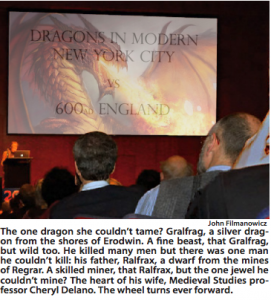Emphasizing their great significance in 5th to 15th century warfare, Medieval Studies professor Cheryl Delano keeps talking about dragons like they actually used to exist during the Middle Ages, sources confirm.

“Professor Delano told us that the Byzantine Empire fell in 1453 when the Ottomans invaded Constantinople ‘on the backs of magnificent dragons,’” said student Greyson Winn ’18. “We all thought it was a joke, but she just kept lecturing. It’s like she actually thinks that dragons are real.”
According to students, Delano has made multiple references to the “razor-sharp talons” and “powerful fire breathing abilities” of dragons, genuinely asserting that the mythical creatures were an integral component of Crusades military strategy.
“Following King Edward’s death in 1066, William the Duke of Normandy sent 7000 men to comb the beaches of Pevensey for rare dragon eggs,” said Delano with alarming conviction as she pulled out a replica of a dragon’s egg she assumed was to scale. “There were thought to be only two eggs remaining in the entire Western Roman Empire, and many thought William was a fool. But his men did indeed find four dragon eggs, and his army swiftly defeated the English at the Battle of Hastings.”
“Once the dragons had imprinted on Duke William, they soared into the sky and burned Harold’s cavalry to a crisp with their mighty fire breath,” added Delano, her vocal inflections revealing not an ounce of doubt. “The arrows of Harold’s men were futile up against the dragon’s impenetrable dragon scales.”
“I went to office hours to find out whether or not any of these weird made-up dragon anecdotes might actually show up on our midterm,” said student Lindsay Pia ’19. “Professor Delano told me to pay extra attention to Visigothic dragons and Persian dragons, and she sounded dead serious.”
“Persian dragons’ wingspans were a full 10 feet longer,” added Pia with a sigh.
At press time, Delano casually mentioned that there were also goblins aboard Viking ships.
